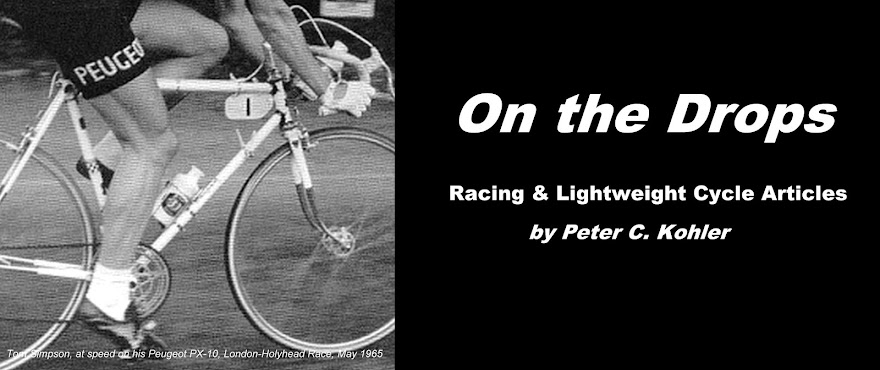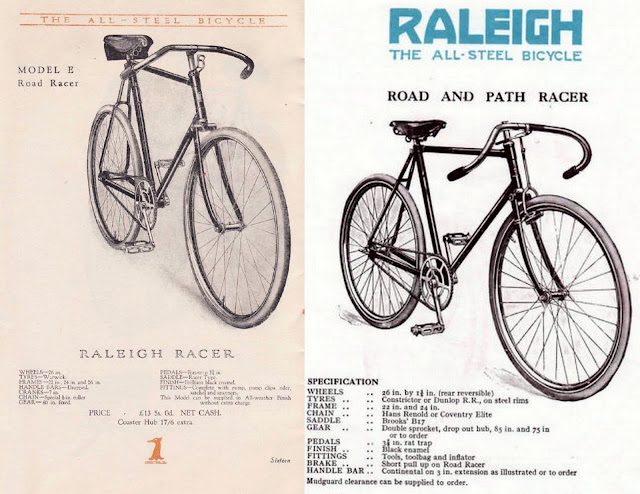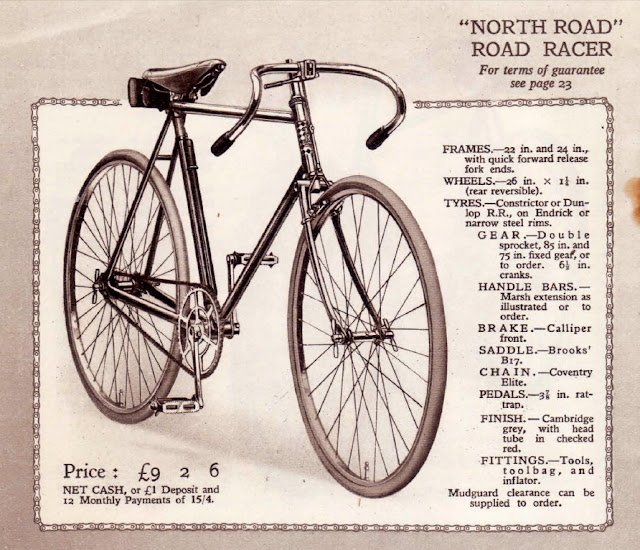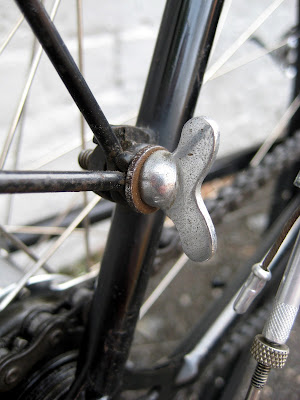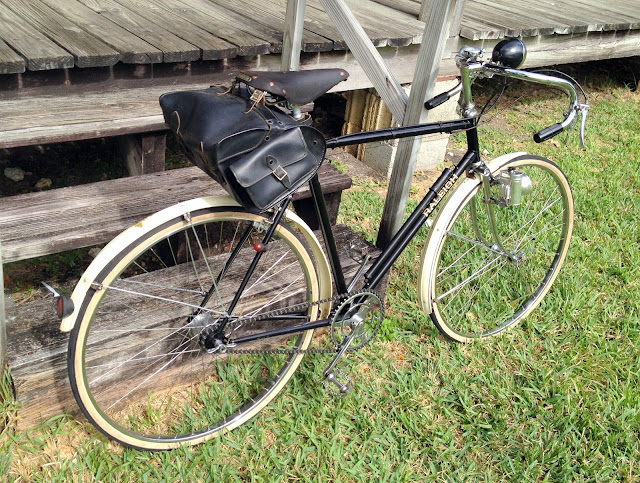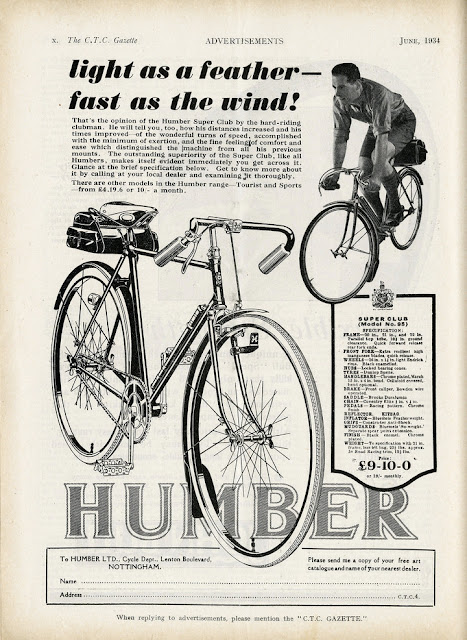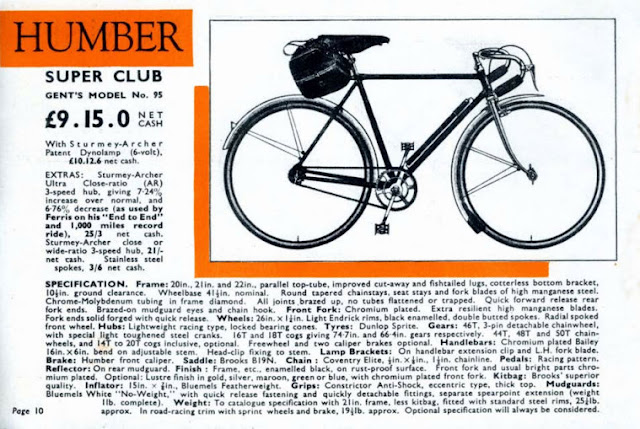 |
| Front cover of "Cycling" depicting the rare "Racing" version of the Raleigh Record offered only in 1931. |
The Raleigh Cycle Co. are specialising in the production of specialty built models for this particular class of cyclist.
All the machines featured here are the result of many months of study, experiment and frequent consultation with leading cyclists in order to offer a specialised series of Raleigh Club and Racing models.
This we feel we have achieved by the demand already apparent.
All the machines featured here are the result of many months of study, experiment and frequent consultation with leading cyclists in order to offer a specialised series of Raleigh Club and Racing models.
This we feel we have achieved by the demand already apparent.
from Raleigh brochure, 1931
With its new post-war range, Raleigh introduced a series of "road racers" for the 1919 model year with the Model E Road Racer and expanded in 1921 to three models: Model G Path Racer, Model H and Model T Road Racers. These were basically pre-war designs with bolted-on backstays and sloping top tubes. Rather more forward looking was a novel all-welded lugless model introduced in 1923. This proved unsuccessful due to frame fractures and was withdrawn and replaced by a conventionally lugged framed Road and Path Racer with a straight top tube and steel 26" x 1⅜th wheels.
"NORTH ROAD ROAD RACER" (NRRR) (1925-1927)
"There will be wide interest in a new model which is being introduced after long and careful experiment and research, known as the 'North Road' model. It has been built under the advice of one of the greatest road-racing experts of the day, and is certain to be a popular model among speedmen", so the "Western Times" of 25 September 1925 reported the introduction of Raleigh newest racing machine. The "road racing expert" mentioned was cycling reporter F.T. Bidlake and the design was based on the French Alcyon racer. After incorporating Bidlake's refinements, initial production of 50 machines began in June 1925 and by the following March, some 90 NRRRs were being made every week. There were issues in producing an appropriate brake and after attempting this in house, Raleigh contracted with F.W. Evans to produce a brake of his design as well for his hubs and fork ends. (Hadland, Raleigh: Past and Presence of an Iconic Bicycle Brand).
The North Road Road Racer was the first really modern Raleigh racing frame with all-brazed up construction (replacing the bolted-on backstay) and low bottom bracket (10½") and offered in a 22" or 24" frame size with or without clearance for optional mudguards. The NRRR as it was known presented a very attractive and distinctive appearance being finished in Cambridge Grey with a red and gold checked head tube when almost all racing bikes were austerely black. New type F.W. Evans patent quick release hubs with wingnuts, fork ends and short-rod pull-up caliper front brake were fitted and the rims were the new 26x1¼ racing Dunlop Endricks the limited availibility of which intially delayed deliveries of these machines. A Brooks B17 saddle was fitted as were Marsh pattern drop 'bars and not, curiously given the machine's name, North Road drops, with John Bull Gristly grips. An extra note of distinction, a newly designed Heron's Head lamp bracket, was fitted to the stem clip, from April 1927 onwards. Priced at £8.12.6. (raised to £9.2.6. by 1927), the NRRR came on the scene when sports and racing machines were enjoying newfound demand and popularity.
The North Road Road Racer was the first really modern Raleigh racing frame with all-brazed up construction (replacing the bolted-on backstay) and low bottom bracket (10½") and offered in a 22" or 24" frame size with or without clearance for optional mudguards. The NRRR as it was known presented a very attractive and distinctive appearance being finished in Cambridge Grey with a red and gold checked head tube when almost all racing bikes were austerely black. New type F.W. Evans patent quick release hubs with wingnuts, fork ends and short-rod pull-up caliper front brake were fitted and the rims were the new 26x1¼ racing Dunlop Endricks the limited availibility of which intially delayed deliveries of these machines. A Brooks B17 saddle was fitted as were Marsh pattern drop 'bars and not, curiously given the machine's name, North Road drops, with John Bull Gristly grips. An extra note of distinction, a newly designed Heron's Head lamp bracket, was fitted to the stem clip, from April 1927 onwards. Priced at £8.12.6. (raised to £9.2.6. by 1927), the NRRR came on the scene when sports and racing machines were enjoying newfound demand and popularity.
 |
| In April 1927 Raleigh introduced its famous Heron's Head lamp bracket, a design that in various forms and variations would be used for over half a century. |
The immediate post-war era saw an increase in cycle sport in Britain, prompted by more leisure time and better roads which permitted lighter, faster machines with more narrow and smaller wheels and tyres (26"x1¼" becoming the standard for club/racing machines by the mid 1920s) and lower bottom brackets giving a more stable machine with better cornering. Production improvements and easing of wartime inflation also reduced new cycle prices to pre-war levels further encouraging sales.
Competitive and sports cycling in Great Britain was built around many regional clubs as well as some with lifestyle or political affiliations (the Vegetarian CC, the Spartacus (socialists), temperance ones etc) and, in an era when mass start roadracing was banned on British roads, the individual time trial. Even these assumed a clandestine quality, usually run on "secret" courses and at the crack of dawn. And, of course, there was a strict dress code for riders of all-black kit, tights and Alpaca jackets, slicked hair, no caps etc. The machines, too, were almost entirely black with only the most subtle of brand names showing and snobbery and convention prevailed with "factory" machines with pre-set components disdained in favour of "bespoke" custom frames from local makers and rider determined components. But leisure and sports cycling burgeoned in Britain between the wars and there was a demand for "off the shelf", popularly priced club machines as well.
"CLUB RALEIGH" (1928-1930)
Building on the success of the North Road racer, Raleigh made its first real effort to tap the growing club market in 1927. For Raleigh to break into this clique market was challenging for it was not only one of Britain's biggest makers but one associated with roadsters and workaday machines not cycle sport. Its production was built around the "in house" concept in that almost everything on a Raleigh frame was also built by the company or its subsidiaries, principal of which was Sturmey-Archer whose hub gears were an anathema to "clubmen" and their fixed gears. So, from the start, Raleigh advertised that its new club machine was designed with the advice of clubmen and that more than 1,000 riders from 100 or more clubs were consulted and contributed their views and advice towards the development of the new Raleigh with them in mind.
How the Club Raleigh was designed...
Just as the proof of the pudding is in the eating, so the proof of the cycle is in the riding. Here at last is a machine that has been designed throughout by the actual rider himself.
The leading cycling clubs and a few well-known road men were asked for their ideal specification for a club machine. The 'Club Raleigh' is the resulting specification of all the replies sent in.
The illustration on this page shows the machine in its stripped form. In the column on the right is a list of the additions and alterations which may be had to suite the rider's various wishes, and by judicious selection from this list, a machine possessing individuality can be obtained at a reasonable price.
Raleigh catalogue, 1928
Introduced in July 1927 for the 1928 model year, the Club Raleigh featured a basic stock machine for the aspiring rider with an extensive list of added cost options in terms of hubs/freewheels, mudguards, handlebars, rims, tyres and saddles giving the more exacting clubman a reasonably priced "off the peg" model that could be modified to suit preferences and purse. This was the first time Raleigh offered an extensive range of other maker fitments on one of their machines.
The frame retained the all-brazed up construction, parallel top tube and low bottom bracket of the NRRR but introduced lighter and neater round tapered chain and seat stays instead of its flattened roadster style chainstays. A wide range of frame sizes, from 21" to 24" was offered and it had a 42¼" wheelbase with approximately 66° parallel angles. The finish was Raleigh's traditional dipped black gloss enamel with head tube in checked red and gold with Raleigh transfer on the top of the bottom tube. The stock wheelset comprised Endrick 26x1¼ rims, double-butted spokes, front quick release hub and the rear a Evan's patent forward quick release and double fixed sprockets giving 78" and 68" fixed gears. The chainset featured 6½" cranks and rat-trap pedals while a single forward rod activated brake with short pull-up lever was fitted. The handlebars were Marsh pattern bends (15" with a 5" drop) on a forward extension with rubber grips. A seat post mounted frame pump and leather tool bag completed the stock specification and the total advertised weight was 26 lbs. This was the first time, too, that Raleigh offered a ladies frame in a racing bike and the modern straight top tube design as well with a Brooks ladies saddle and 4" drop 'bars.
The stock Club Raleigh retailed for £7.5.0. which represented a tremendous value considering the 1923 Racer cost £11.50 and it was almost £2 cheaper than the NRRR.
What really distinguished the Club Raleigh was the extensive "menu" of 28 different component options "which may be had to suit the rider's various wishes, and by a judicious selection from this list, a machine posessing individuality can be obtained at a reasonable price." Choices included a rear brake in addition to the front one, Sturmey Archer coaster hub, or free/fixed hub. If mudguards were desired, there was a choice of steel Raleigh ones or Bluemel's Peerless or Noweights in celluloid. Alternate rims included Kundtz laminated wood ones, Narrow Westwoods and choice of Dunlop or Constrictor sew-ups tyres. A range of different Brooks saddles were available including various types of the B17, B18, B19 or Terry's CTC saddle.
 |
| The Club Raleigh as described in "Cycling's" special Cycle Show Number, 4 November 1927. credit: V-CC on-line archives |
Back in the day when the popular press covered such things as new bicycles, the Club Raleigh was lauded as being a "thorough speedman's machine and is the first instance on record of a great manufacturer building a bicycle exactly to a carefully-tested expression of opinion by the public" (North Devon Journal, 21 July 1927) while the Cornishman a day before printed a fulsome review of the new machine:
It is an interesting sign of the times that the Raleigh cycle people should be making a serious and novel attempt to meet the demand for an up-to-date lightweight bicycle, and the sign is a useful one to the cause of cycling, because any move made by so large a firm as the Raleigh Company, is bound to be brought well before the eyes of the public. The 'Club Raleigh', as the new lightweight is named, at weight of 26 lbs, and a price of £7.5.1., is, decidedly, a delightful machine, and the most fastidious rider could not pick holes either in its design or construction. A wide variation to the standard specification is offered, and the machine is fitted with the rear-wheel release which was designed by Mr. F.W. Evans, and awarded the C.T.C. silver plaque for the greatest advance in cycle practice for 1926. A leaflet obtainable at any Raleigh agent, describes the machine, which may be fitted as an easy-going delightfully light roadster, or as a speedman's hot-stuff mount. It deserves to be widely advertised.
All of this evidently proved disappointing in sales or perhaps too complicated to facilitate such a custom specification in what was still the world's greatest mass cycle production and for 1929,the model was renamed Club and offered only as an off the peg model in gents and ladies frames with the same stock components as the previous year except that Dunlop Racing Red tyres were spec'd. The only options were freewheel, rear brake instead of front brake and mudguards. The cost rose to £7.10.0.
In cycling circles during the early months of 1929 the famous Land's End to John O'Groats record was much discussed and opinions freely expressed that England could not produce to-day a rider with the grit and endurance of those giants of the wheel, who had broken previous records. For 21 years Harry Green's record, for which he rode a Raleigh machine, had stood unbroken. During that 21 years Raleigh cycles have held in ever increasing measure the high reputation attaching to the Raleigh name. With a view to still further upholding that high reputation, there was discovered in Rossiter, a cyclist who would make the attempt. How this slim youth set out on August 22nd, 1929, from Land's End is now world-knowledge, and how, within 61 hours 28 minutes he completed his ride of 866 miles breaking a 21 years' old record by 6 hours 28 minutes is a triumph opf masterly achievement acknowledged throughout the land. Rossiter's outstanding success he admits, was due to his complete faith in the machine he rode. During the whole journey, every hill of which was ridden, he was fighting against continuous winds and heavy rain. In his written statement of the event he says--
'I want to tell you how much the Sturmey-Archer 3-speed helped me to break the record from Land's End to John O'Groats. To be perfectly frank, until I started I didn't much believe in it for speed work. I thought it was all right for tourists and ordinary riding, but for speed. I hadn't gone many miles before I realised its advantage. Later in the gruelling ride up the Garry Pass, when the low gear helped me so much against the headwind, in the big sweeps downhill when I could pedal at full rip-- well, for long distance record work I am convinced now that a Sturmey-Archer adds miles an hour.
I would never have done that last bit, Inverness to John O'Groats 143 miles, in just over 10 hours, at the end of 2½ days riding, if it hadn't been for the Sturmey-Archer, and I wouldn't have anything else after this experience'
Raleigh catalogue 1930
Jack Rossiter used a stock Club model with a Sturmey-Archer K wide-ratio hub, Dunlop tyres, Brooks saddle (which appears to be a B-19) with a Resilion-padded cover, Lucas bell and lamp and Bluemel's spearpoint extension mudguard. This machine was displayed in various Raleigh dealers over the coming years and, remarkably, survives to this day having passed to a Raleigh worker and used as a commuter cycle for many years in Nottingham.
Starting from Land's End at 8.00 am on Thursday 22 August 1929, Rossiter reached John O'Groats on Saturday the 24th at 9.22 pm for a total of 61 hours 22 minutes including all stops for food and rest. Despite using a 28½-mile longer route than Harry Green, Rossiter bested his time by an impressive 6 hours and 28 minutes, averaging in excess of 14 mph and, for the first time, cycling the entire course even the previously impossibly hilly portions. "Throughout the whole of the journey Rossiter was never distressed, and no doubt, the intelligent use he made of the Sturmey-Archer 3-speed gear, especially when climbing Shap, The Ord of Caithness and Berriedale, enabled him to husband his strength" (Raleigh 1930 catalogue) It was indeed a tremendous achievement by man and machine and especially for the Sturmey-Archer three-speed hub showing its potential for racing and long distance work in the most dramatic fashion. And it thrust Raleigh back into the public spotlight in competitive cycle sport rather than workaday roadsters and furthered the development of the sport/racing range.
Starting from Land's End at 8.00 am on Thursday 22 August 1929, Rossiter reached John O'Groats on Saturday the 24th at 9.22 pm for a total of 61 hours 22 minutes including all stops for food and rest. Despite using a 28½-mile longer route than Harry Green, Rossiter bested his time by an impressive 6 hours and 28 minutes, averaging in excess of 14 mph and, for the first time, cycling the entire course even the previously impossibly hilly portions. "Throughout the whole of the journey Rossiter was never distressed, and no doubt, the intelligent use he made of the Sturmey-Archer 3-speed gear, especially when climbing Shap, The Ord of Caithness and Berriedale, enabled him to husband his strength" (Raleigh 1930 catalogue) It was indeed a tremendous achievement by man and machine and especially for the Sturmey-Archer three-speed hub showing its potential for racing and long distance work in the most dramatic fashion. And it thrust Raleigh back into the public spotlight in competitive cycle sport rather than workaday roadsters and furthered the development of the sport/racing range.
Raleigh lost no time in capitalising on the Rossiter record and by November 1929 introduced two new variants on the Club model for the 1930 model year. The first, the Ace, was a de luxe version of the Club in 20" to 24" frame sizes in a distinctive Cambridge Grey with a red and gold checked headtube, red Shockstop handlebar grips and Dunlop Racing Red tyres, 26x1¼" Endrick rims, 2 fixed sprockets, single rear brake, Marsh pattern 15" wide 'bars with 6" drop on an adjustable swan neck stem and aluminium mudguards. Weighing 26 lbs, the Ace sold for £7.19. 6. A ladies model was offered as well in 20" to 22" frame sizes, having rubber pedals instead rat-trap racing ones and 4" drop Marsh bends instead of 6". The second, the New 1930 Club, also finished in Cambridge Grey, was fitted with a Sturmey-Archer K three-speed rear hub gear as standard and differing from the Ace in having Marsh 'bars on a brazed extension, Junior Shockstop grips and no mudguards except for an aluminium spearpoint extension only. Both models featured a new pattern brake that was cable activated but still used the older rod style pull-up caliper. The 28 lb. machine was priced at £8.8.0. and there was also a ladies model.
The Raleigh Club proved to be both popular and enduring, as an article in the Exeter & Plymouth Gazette of 11 March 1930 reported: "Many people think that a light bicycle will not stand heavy usage, but there be no need to fear on this point, provided the machine is of good make. Mr. G.H. Ferry, of 89 Cowley Road, Uxbridge, writes that he has ridden his light Club Raleigh 9,318 miles 'through country lanes and along car tracks,' and describes it as 'simply wonderful.' The essential point, of course, is the design and the manufacture, and with such a machine as the Raleigh, the rider need have no fear on these points."
"RALEIGH RECORD" (1931-1933)The Raleigh Club proved to be both popular and enduring, as an article in the Exeter & Plymouth Gazette of 11 March 1930 reported: "Many people think that a light bicycle will not stand heavy usage, but there be no need to fear on this point, provided the machine is of good make. Mr. G.H. Ferry, of 89 Cowley Road, Uxbridge, writes that he has ridden his light Club Raleigh 9,318 miles 'through country lanes and along car tracks,' and describes it as 'simply wonderful.' The essential point, of course, is the design and the manufacture, and with such a machine as the Raleigh, the rider need have no fear on these points."
Great interest has been aroused by the introduction of a new range of sports and racing machines which will be known as the 'Raleigh Record' and 'Raleigh Popular Sports' ranges. These models will undoubtedly win instant favour and the racing model is likely ro test the vast Raleigh works to the utmost capacity, while for sheer beauty and style the Ivory Chrome will find a ready market.
Exeter & Plymouth Gazette, 18 September 1930
1931 marked a new departure for Raleigh in that for the first time it offered a new range of true lightweight cycles,both for racing/club riding and touring, in the new molybdenum tubing which was lighter and stronger than conventional tubing. Honouring the Rossiter record, the new series was dubbed the Record, a model name that would be used for myriad Raleigh models for some 60 years
Announced on 18 September 1930, the Raleigh Record replaced the Club and Ace models and marked a further foray into the popularly priced club and racing market with an improved machine with the latest racing oriented components and with several distinct submodels offered, including the first de luxe lightweight Raleigh, to cater to both the "speedman" and the top end leisure market.
"Cycling" described the new Sports and Record models as being designed "with a real regard for the individual requirements of racing men and tourists. They are all constructed with well-raked steering heads and front forks...Features common to all models are the use of molybdenum tubing, solid fork ends, brazed joints and a total absence of tube flattening or trapping. The front wheels are built up with radial spoking; this system has been subjected to the most drastic tests in races and over rough roads and has proved the superior of the normally constructed wheel both in regard to lightness and appearance... On all this new family of lightweights it will be seen that no pains have been spared to obtain a really remarkable finish."
Announced on 18 September 1930, the Raleigh Record replaced the Club and Ace models and marked a further foray into the popularly priced club and racing market with an improved machine with the latest racing oriented components and with several distinct submodels offered, including the first de luxe lightweight Raleigh, to cater to both the "speedman" and the top end leisure market.
"Cycling" described the new Sports and Record models as being designed "with a real regard for the individual requirements of racing men and tourists. They are all constructed with well-raked steering heads and front forks...Features common to all models are the use of molybdenum tubing, solid fork ends, brazed joints and a total absence of tube flattening or trapping. The front wheels are built up with radial spoking; this system has been subjected to the most drastic tests in races and over rough roads and has proved the superior of the normally constructed wheel both in regard to lightness and appearance... On all this new family of lightweights it will be seen that no pains have been spared to obtain a really remarkable finish."
The basic racing model, the Record, was manufactured of the latest molybdenum tubing fully brazed up and with round tapered chainstays, seatstays and fork blades with quick release fork ends front and back. Frame sizes were 20", 21" and 22" with a 41" wheelbase and 67/67° parallel frame angles and a 10½" bb height.
The wheelset comprised Dunlop Endrick pattern 26"x1¼ black enamelled 32/40-hole rims with Raleigh chromed racing "drop-out" hubs with wingnuts and the front wheel featured radial spoking. The tyres were Dunlop Racing Reds. A new pattern three-pin detachable chainset with 6½" fluted cranks came with choice of 44, 46, 48 and 50-tooth chainring with double fixed sprockets in a choice of 14 to 20t. Brampton B-10 racing quill pedals were standard. The new style single cable operated Raleigh brake caliper was bolted through the front fork crown and the rear seatstay bridge was drilled for an optional rear brake. The handlebar was a 15" wide Marsh bend with a 6" drop, black celluloid covered with 5" Constrictor Anti-Shock grips on a swan-neck adjustable extension.
New were the black Bluemel's "No-Weight" mudguards and separate spearpoint extension with Raleigh's and Charles Marshall's patented (November 1930) quick-release fittings using wingnuts and spring clip bridge fitments and new pattern brazed on attaching clips higher up the front fork and rear stays to enable shorter, lighter stays.
The Record came with a Brooks B-17 saddle, 10" modern straight seat pin instead of the older "gallows" post of the Club, Raleigh pattern leather saddle toolbag and a Raleigh celluloid 15-inch frame-fitted Apex inflator. This was the first model to have the new fork-mounted Heron lamp bracket which was initially fitted to the right fork blade.
Beautifully finished in gloss black enamel and with its black 'bars and rims, the Record fitted right in with the "all black" era of British cycle sport of its day. The previous Club model's popular Cambridge Grey with checked head was also available as a extra cost (5/-) options.
As with the previous Club model, the Record was offered in a ladies frame version in 20" and 21" with a Brooks B18 saddle, 4" drop Marsh 'bend bars and rubber pedals.
Costing £8.12.6. the Record represented a well designed and engineered entry level racing/club machine of the best quality and was an immediate success.
If ever a cyclist has to remove his chain-wheel from any ordinary bicycle his language is likely to be lurid. Usually it is a bench job. But in the Record Raleigh-- the favourite of all speed men-- the chain-wheel is provided with a three-arm fixing, so that it can be easily slipped over the crank, pedal and toeclip. The changing of a chain-wheel on a Raleigh is only a matter of moments.
Every experienced cyclist knows that one of the secrets of easy hill-climbing lies in the reliability of the steering, and a feature of the 'Record' Raleigh is its perfectly designed steering head. The 21" frame has a 6¼" head, (other frame sizes in proportion), and for strength, lightness and reliability it is without equal. This provides one of the many reasons why a Raleigh will glide uphill when an ordinary machine is unloading its rider to walk.
One of the many improvements in the bicycle is incorporated in the Record Raleigh which is fitted with full-size celluloid guards, secure and rattle-proof; yet they can be instantly stripped and off without use of tools. Moreover when the main guards are removed, there still remains over the front wheel a light but effective celluloid 'Spearpoint.' Without this, eyesight is in grave danger and comfort impossible.
Old-fashioned bicycles have their headlights over the front wheels, a most awkward position when, in the rain, the rider wears his cape, but the Record Raleigh has introduced a new and practical fashion. The lamp-bracket is fitted to the left fork, where it is not effective as a headlight, but shows a light on grass edgings and footpaths at the side of the road, invaluable in a fog. Consequently, the Raleigh rider can keep well to the left, without being danger from the roughness of the gutter. It would be well if other bicycle makers would follow the lead which the Raleigh, as usual, has given.
Ladies are taking a greater interest in the bicycles they ride, and the new 'Record" Raleigh has been built specially for their use, with the same care and thought as is expended on the men's machines. For instance, by the use of straight tubes throughout the frame-- set at correct angles-- great rigidity and therefore easier running is obtained, as well as much greater strength. The lady's model becomes as easy to ride as a man's bicycle, and the 'Record' Raleigh will thus mean better and happier cycling in the feminine world.
"RECORD IVORYCHROME" (1931-1933)
"RECORD RACING" (1931)
In addition to the standard Record club model were two variations. A de luxe club model, the Record Ivorychrome for gents and ladies featured a special ivory livery with red lining and transfers, chromed front fork, ivory celluloid-covered 'bars and chromed Endrick rims and costing £9.10.0.
Only offered in 1931 was the Record Racing model for gents only at £10.10.0. with specialised racing components including the wheelset comprising Constrictor wood sprint rims with Dunlop no. 3 sew-ups or Constrictor 50 sew-ups with black spokes, radially laced front wheel and higher 78 inch/83 inch fixed gears, Constrictor Boa racing pedals, and chromed Marsh 'bars as standard rather than celluloid-covered.
 |
| A detail from a delightful Raleigh advert on the cover of Cycling depicting a Record "all out" on a time trial. The obligatory (by law) bell and all-black kit (by convention and custom) is depicted. |
Concurrent with the new Record model, Sturmey-Archer sought to tap into the growing "club", racing, timetrialling and racing market building on the Rossiter record with a new range of closer ratio hubs. Then, almost all "clubmen" in Britain used fixed gears and multiple gears, hubs or early derailleurs, were largely shunned. Rossiter had used a standard wide ratio (33.75% reduction/25% increase) K hub on his record ride but what was really needed for racing and time trialling was a closer ratio unit. Raleigh rider Charles Marshall undertook his own tweaking of the existing K unit to achieve closer ratios starting in 1930 (one of these hubs was used in his record breaking London-Bath-London ride 8 July 1931) and development was continued by Sturmey-Archer engineers.
In 1932 the two new racing/club hubs, the close ratio KS (12.5% reduction/11.1% increase) and the medium ratio KSW (16.6 percent reduction/14.3 increase) were introduced. With racing in mind, every effort was made to reduce weight and they were the first S/A hubs with easier to change sprockets, wingnuts for easy wheel changes without disturbing the cone adjustments and quick release gear cable connection. These represented the most that could be accomplished with Sturmey's original single stage epicyclic hub design and with them, hub gears gained a gradual if grudging acceptance in the tradition-bound world of club cyclists.
To popularise the new hubs, they were offered as extra cost options for the Record in 1932. The base price of the machine was dropped in November 1931 to £7.17.6. with fixed gears, £8.17.6 with a K hub or £9.3.6. with a KS or KSW including a rear caliper brake in addition to the stock front one. For the aspiring club rider, the Record was a good machine ("the Clubman's Ideal") at a low price even if the ethos of British cycling then generally disdained factory made/fitted machines in favour of regional bespoke frames fitted to choice.
 |
| From "Cycling" December 1931 advertising the cheaper, improved Record model for the '32 year. |
 |
| Showing the pre-1932 seat tube transfer on this machine, original radially spoked front wheel, 1932 pattern wingnuts and chainset. Credit: Jon Bentley |
 |
| Original down to the tool bag and the early pattern Bluemels muguards. Credit: Jon Bentley |
 |
| Details of this exceptional machine showing the seat tube transfers, chainset and the stem/'bars. Credit: Jon Bentley |
The 1932 model year saw a number of improvements/changes to the Record:
- a 23-inch frame offered in addition to 20", 21" and 22".
- new "R" pattern wingnuts on wheel axles
- new Raleigh racing quill pedals with little Herons heads
- new Raleigh chain ring incorporating the Heron Head
- new Raleigh racing hubs with locked bearing cones and spring clip to oil hole
- white Bluemel No-weight 'guards as an alternate to the stock black ones
- "Raleigh" in gold blocks (this marked the first use of this distinctive typeface transfer that would be used for various Raleighs and repaints for another 40 years) on downtube replaces "Raleigh" on seat tube
- fork lamp bracket changed from right to left fork blade as standard (could be special ordered to fit leftside)
 |
| The improved 1932 Record as depicted in that year's catalogue. credit: V-CC on line catalogue archives |
 |
| The Record Ivory Chrome featured in the 1933 brochure (not appearing in the '32 one). credit: V-CC on-line catalogue archives |
 |
| Original condition 1932 Raleigh Record as offered on eBay in 2014. |
The improved Record was a thoroughly attractive and distinctive racing/club machine and proved to be one of the Raleigh best sellers. It, the Club and North Road Racer did much to establish Raleigh in the competitive and sports market and paved the way for the new Record Ace which would replace the Record for the 1934 model year. Even the fabled RRA was an improved Record with a lighter frameset and slightly updated components. Raleigh’s newfound involvement in road racing and records that started in the immediate post-World War One era would culminate as late as 1980 when a Raleigh cycle and professional team won the Tour de France.
 |
| Two charming Raleigh adverts for the Record in “Cycling” (left: 8 May 1931 right: 8 April 1932) capture the inter-war heyday of the British time trial. |
Acknowledgements/Credits
Paul Whatley, Raleigh Marque Specialist, V-CC
Raleigh, Past and Prescence of an Iconic Bicycle Brand, Hadland, 2011
Websites: ThreeSpeedHub, Veteran Cycle Club online library, Classic Lightweights UK
RALEIGH RACING BICYCLES CATALOGUE PAGE ALBUM 1919-1933
www.ipernity.com/doc/286349/album/589461
